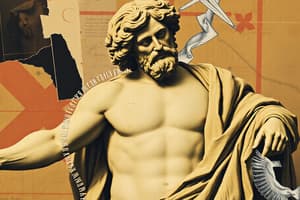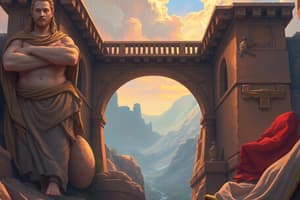Podcast
Questions and Answers
The term referring to the re-birth of classical ideals and art is the ______________.
The term referring to the re-birth of classical ideals and art is the ______________.
Renaissance
Match the following definitions with the appropriate term:
Match the following definitions with the appropriate term:
Renaissance = Rebirth of classical ideals and art Humanism = Emphasis on human values and agency Naturalism = Artistic representation that strives for visual accuracy Fresco = A painting done rapidly in watercolor on wet plaster on a wall or ceiling, so that the colors penetrate the plaster and become fixed as it dries
Which artist is known for the Dome of Florence Cathedral?
Which artist is known for the Dome of Florence Cathedral?
- Giotto
- Botticelli
- Brunelleschi (correct)
- Donatello
Linear perspective creates the illusion of depth through atmospheric effects such as blurring and color changes.
Linear perspective creates the illusion of depth through atmospheric effects such as blurring and color changes.
Explain the significance of Florence in the development of Renaissance art, mentioning a prominent family and an artwork they patronized.
Explain the significance of Florence in the development of Renaissance art, mentioning a prominent family and an artwork they patronized.
A work with two panels is called a _________, and a work with three panels is a called a _________.
A work with two panels is called a _________, and a work with three panels is a called a _________.
What defines the purpose of the 'Gates of Paradise'?
What defines the purpose of the 'Gates of Paradise'?
Flashcards
Fill-in-the-blanks
Fill-in-the-blanks
Typically a 1-to-2-word answer.
Short Answer
Short Answer
Answer in sentences, typically 1-3 sentences (up to a maximum of 5).
Altarpiece
Altarpiece
An artwork consisting of multiple panels.
Oil Paint
Oil Paint
Signup and view all the flashcards
Linear Perspective
Linear Perspective
Signup and view all the flashcards
Atmospheric Perspective
Atmospheric Perspective
Signup and view all the flashcards
Diptych
Diptych
Signup and view all the flashcards
Triptych
Triptych
Signup and view all the flashcards
Polyptych
Polyptych
Signup and view all the flashcards
Fresco
Fresco
Signup and view all the flashcards
Study Notes
- Exam includes multiple choice, fill-in-the-blanks, short answer, and visual analysis sections
- The exam is 80 minutes, with timed, separate parts
Exam Question Types
- Study guide content may appear in multiple choice, fill-in-the-blanks, or short answer formats
- Fill-in-the-blanks require 1-4 word answers
- Short answers require 1-5 sentences
- Use original wording rather than lecture notes
- Using your own words is essential for demonstrating understanding
Images to Study
- Be familiar with the following images:
- Giotto, Madonna Enthroned
- Lorenzetti, Peaceful City; Lorenzetti, Peaceful Country
- Brunelleschi, Dome of Florence Cathedral (dome only)
- Ghiberti, Gates of Paradise & Isaac & His Sons
- Massacio, Holy Trinity
- Donatello, David
- Botticelli, Birth of Venus
- Perugino, Christ Delivering Keys to St. Peter
- Della Francesca, Battista Sforza & Federico da Montefeltro
- Della Francesca, Brera Altarpiece
- Van Eyck, Ghent Altarpiece (open & closed)
- Campin, Merode Altarpiece (open)
- Fra Angelico, Annunciation
- Van Eyck, Arnolfini & His Bride (Wife)
- Van der Goes, Portinari Altarpiece
Image Identification Criteria
- For each image, know the following:
- Artist and patron
- Title
- Date
- Period: Proto-Renaissance or Early Renaissance
- Regional Style: Northern Renaissance/ Flemish or Southern Renaissance/ Italian
- Locations: City names for buildings and frescoes
- Exception: Know the specific buildings in Lorenzetti's and Perugino's frescoes.
- Medium
- Relation to Naturalism, Humanism, or Renaissance concepts
- Significance, function, or story
- Use of linear and/or atmospheric perspective
Key Definitions
- Define the following terms:
- Altarpiece (open/close)
- Oil Paint
- Florence & the Medici
- Holy Trinity
- Secular
- Portraiture/ Portrait
- Patron/Sitter
- Linear Perspective, Vanishing Point, Orthogonal
- Atmospheric Perspective
- Flanders/Flemish
- Diptych/Triptych/Polyptych
- Northern Renaissance/ Flemish 15th c.
- Southern Renaissance/ Italian 15th c.
- Written definitions must be in your own words
Essay/Answer Questions to Prepare
- How did Renaissance Humanism differ from Middle Ages outlooks?
- Which paintings show secular life and humanism in 14th c. Italy or 15th c. Flanders and Italy?
- How did Italian city-states govern themselves in the 15th century?
- Which city was most important artistically in 15th-century Italy, and which family supported art there?
- What does RENAISSANCE mean in art? Which artworks prove it in 15th century Italy?
- Why was David important to Florence?
- Brunelleschi’s contribution to 2D art. ; Alberti's expansion of it.
- How to achieve depth of field with atmospheric perspective
- How to achieve depth of field with linear perspective
- How to ascertain if an image uses linear/atmospheric perspective, and where the vanishing point would be
- How do patrons appear in religious paintings?
- Why was oil paint better than tempera or fresco for naturalism?
- Examples of bronze artworks
- Did HUMANISM and NATURALISM grow in 15th c. Flanders?
- Religious symbolism in 15th c. Italian or Flemish, specifically Virgin Mary
Long Answer Preparation
- Prepare answers in advance for typing into the exam
- Study the artworks in detail, can expect one or two to appear on the exam.
- Proctorio will not permit copy & pasting
- Identification item answers (artist, patron, etc.) will not be included in paragraph word count
Long Answer Requirements
- Paragraph answer minimum of 100 words, maximum of 150 words
- Art-work: Mantegna, Camera Picta including the two wall details with the images of the patron, images of the patron are in two walls.
- What image did the patron project in each artwork? How did he want to be remembered? I.e. What did each man want to tell the viewers about who he was (his status, job or personality, role in life etc.)? Proof your points by discussing relevant visual evidence in the paintings
- Was the patron of the portrait a Humanist? Why or why not? Explain by discussing relevant visible evidence in the paintings. (HINT: Define what Humanism first and then prove it by discussing the image).
- Artworks: Campin, Merode Altarpiece, Fra Angelico, Annunciation
- What are the characteristics of 15th century Flemish paintings? There are five.
- What are the characteristics of 15th century Italian paintings?
- What are the key differences between 15th century Italian paintings and the ones from Flanders?
Additional Notes
- Mystery Image section may use unfamiliar artwork.
- Identify as Northern/Flemish or Southern/Italian Renaissance, and reasons.
- Applying knowledge of art history is key to determining what the artworks that are not in textbook are
Studying That Suits You
Use AI to generate personalized quizzes and flashcards to suit your learning preferences.




